Nothing starts a lively conversation among Labrador fans quite so quickly as the topic of silver Labs! Silver Labradors are basically chocolate Labs with a twist. They have a gene that dilutes that rich chocolate fur and turns it into a pale, silvery grey color.

Where that gene came from, how it got into Labs and whether it should be there at all, is a debate that has been raging for decades. So I’m going to dig into the evidence and find out what’s going on with this controversial Lab!
- What are silver Labs really like?
- Introducing the dilute gene
- The great silver Lab controversy!
- Pros, cons, and buying tips
Whether you think the Silver Lab is a disaster or a delight, you should find plenty here to interest you and you’re welcome to add your thoughts to the many comments below. Let’s start with the facts and then move on to the debate.
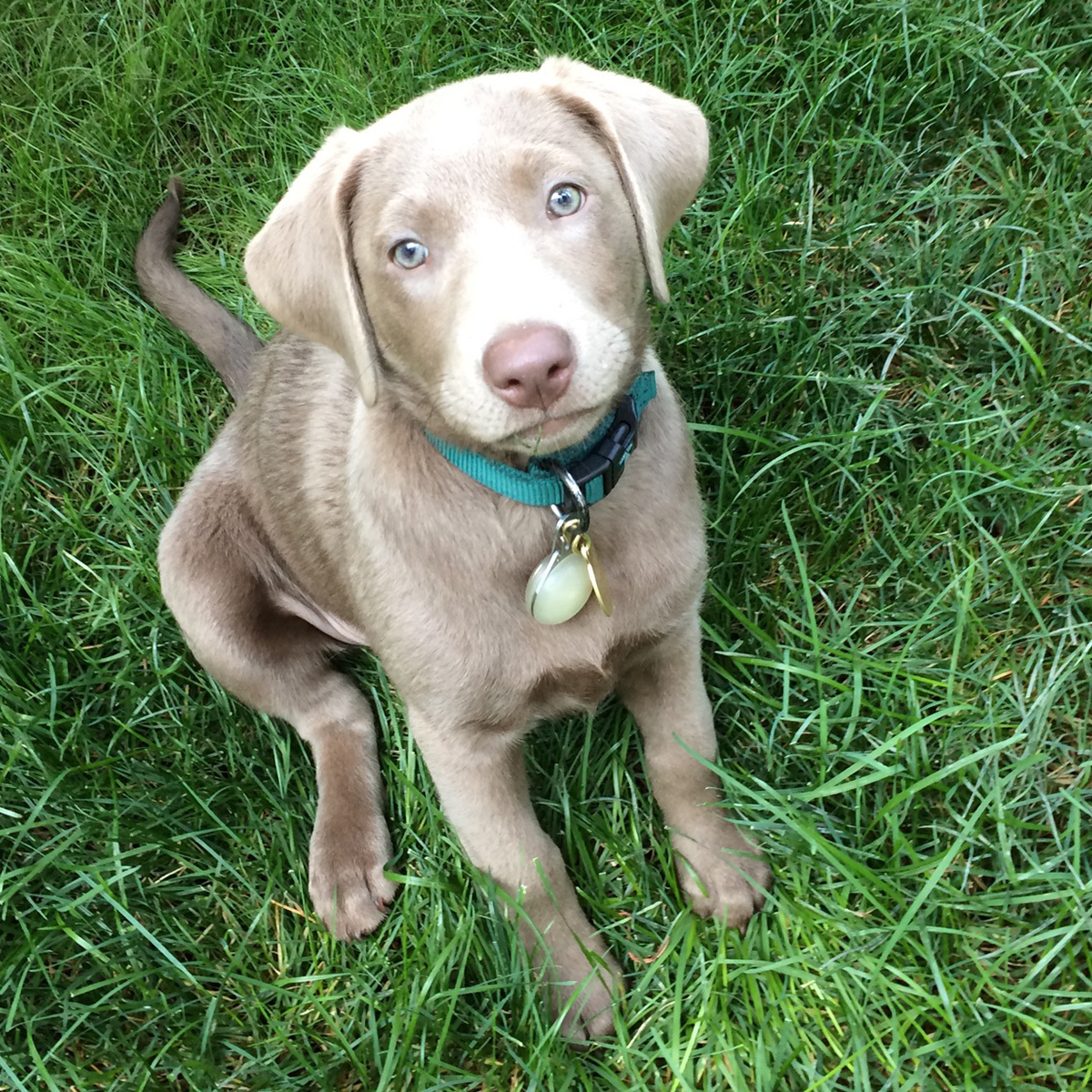
Introducing The Dilute Gene
There are only three different colors of Labrador Retriever recognized by the American Kennel Club. Those colors are:
Missing from the list you’ll notice are cream, white, fox-red, champagne, charcoal and silver. The first three are simply variations in the coat color of the yellow Labrador, and are registered with the AKC as yellow Labs.

The last three, are a bit different. They are dilutions of the three major colors. Champagne is a dilution of yellow. Charcoal is a dilution of black, and of course silver is a dilution of chocolate.
The coat color dilution gene is common in many animals including dogs, cats and rabbits. And the AKC recognizes several dog breeds in diluted colors. The Weimaraner is one example. And the Chesapeake Bay Retriever is another.
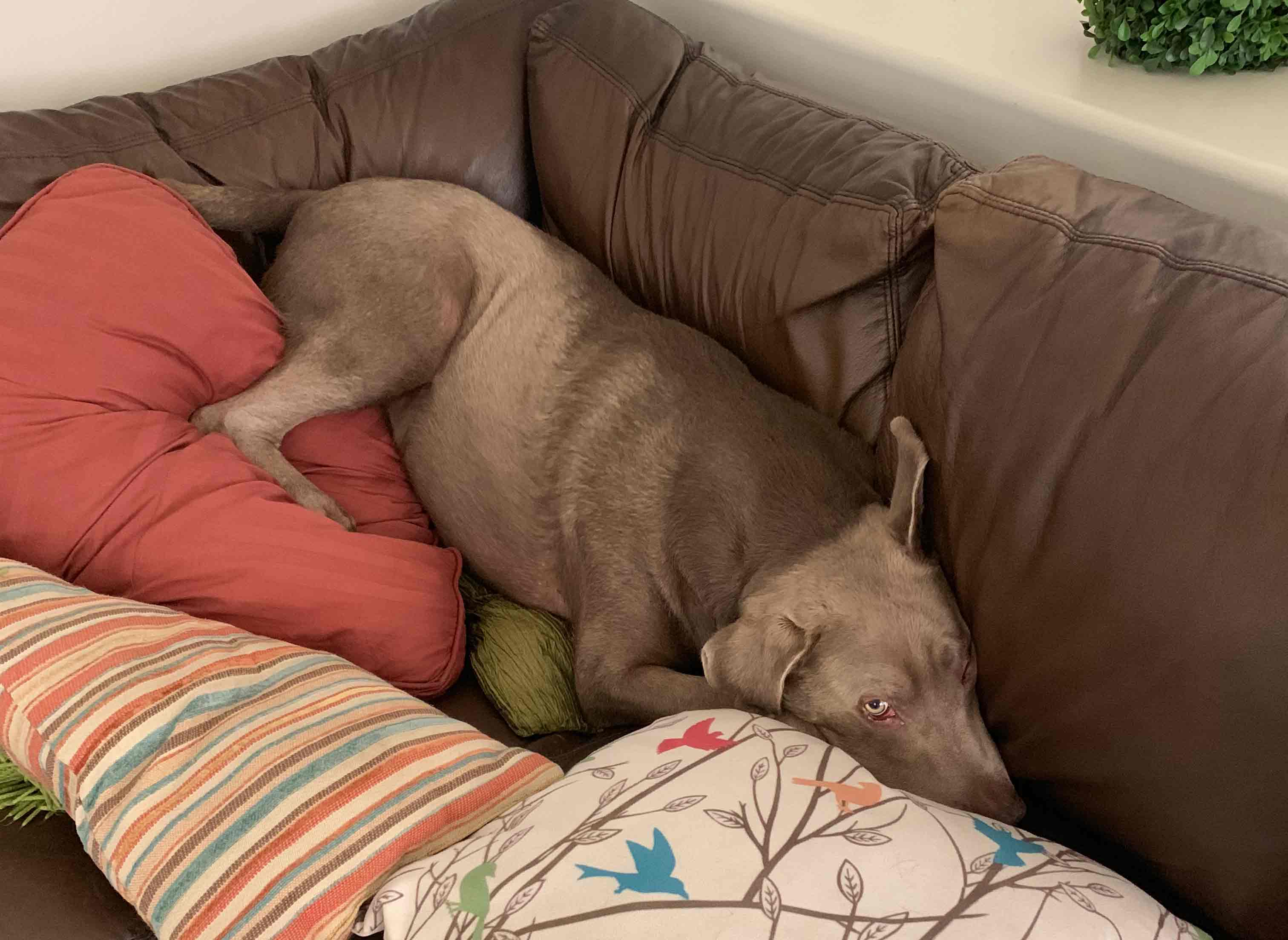
Labradors are not included among those breeds where the dilution gene is accepted. However the AKC will allow silver Labs to be registered, provided they are registered as chocolate.
This is a source of major annoyance to many Labrador enthusiasts. Many of whom think that silver labs should not ever be registered as pedigree dogs. And who believe that admitting these dogs to the breed register has allowed the spread and proliferation of silver Labs to take place across the USA
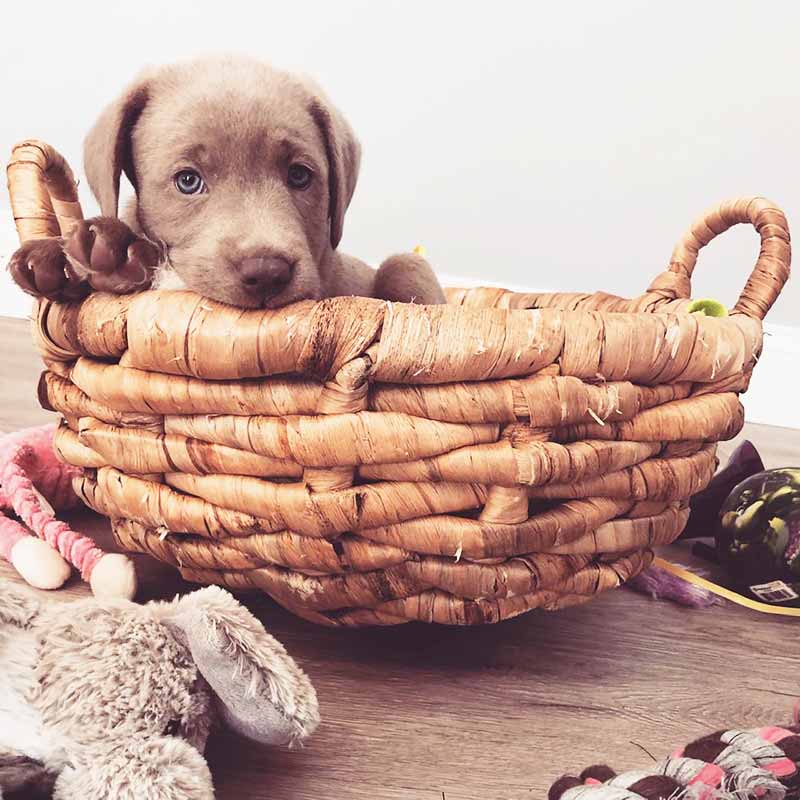
There are many opinions on the rights and wrongs of breeding and registering Silver Labs, and we’ll be taking a closer look at them, but those are the bare facts as they stand at the moment. First let’s dig into the genetics, and find out how we get silver fur on a chocolate Lab.
How The Dilute Gene Works
You can read about the way B and E genes control the underlying coat color of the three recognized Labs in this article on Labrador color inheritance.
The gene that dilutes chocolate fur to silver is known as the D gene. And like many genes, the D gene acts as a type of switch. Every dog with dilution genes inherits a pair of them. One from each parent. And there are two types of D gene. Big D and little d
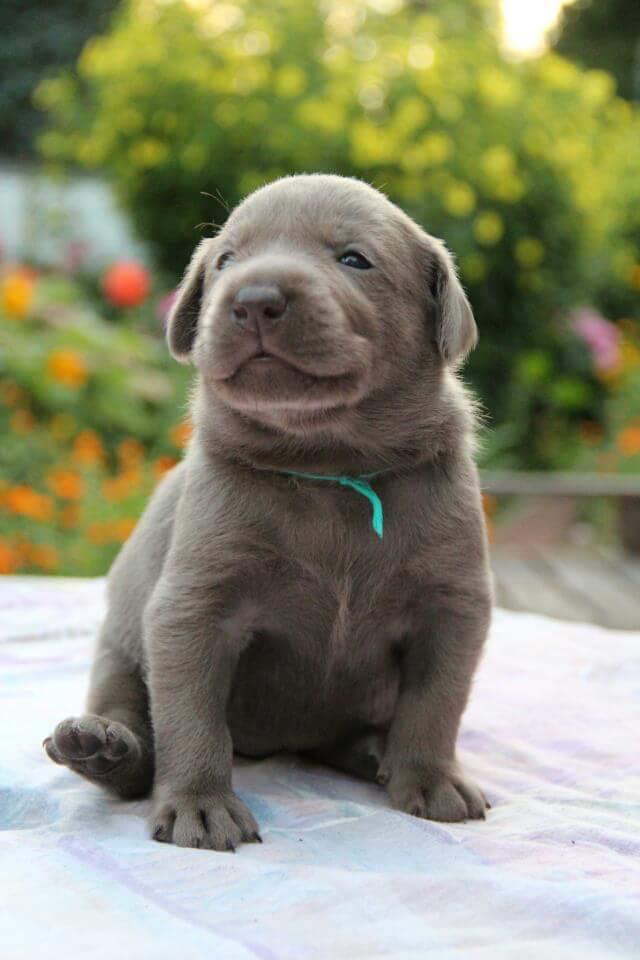
So there are three possible combinations that your Labrador can inherit
- DD
- Dd
- dd
Only a chocolate dog with two little ds can be silver. That’s because the big D gene is dominant. It over-rides, or switches off, the little d gene whenever they are paired together. So if your dog inherits just one little d gene, the color dilution will not take place and your dog will have a normal full strength chocolate coat. They will however, pass on that little d gene to around half of any puppies they may have.
In some breeds of dog, all individuals have two little d genes. Weimaraners are one example. And for many decades there were no recorded instances of the dilute coat in Labrador Retrievers.
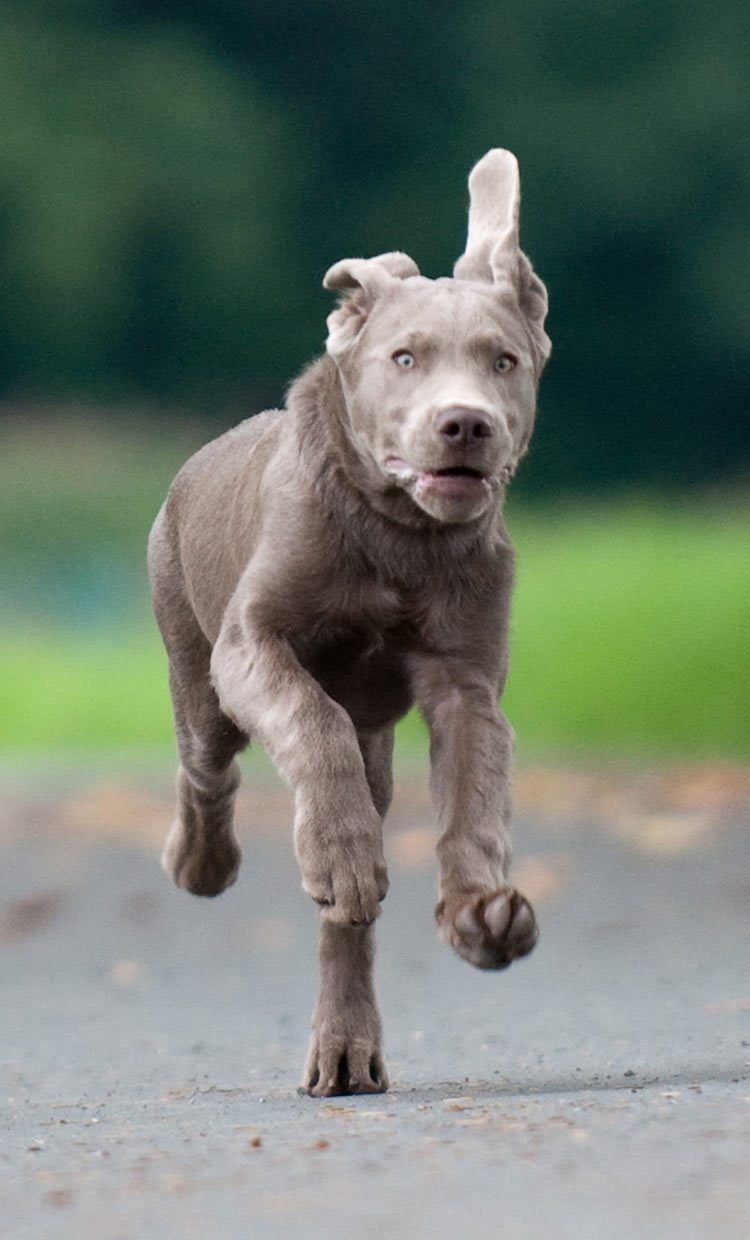
Which raises a number of questions, including:
- When did the dilute gene first appear in Labradors?
- How did the dilute gene get into the Labrador breed?
- Should silver Labs be registered as pedigree dogs?
We’re going to go into those in some detail in a moment. But first let’s look at what you and your family are getting into, if you decide to buy a silver Lab puppy.
What Are Silver Labradors Really Like?
Silver Labs make great family pets. They need plenty of exercise and are ideally suited to active, outdoor life.
All Labradors can be very bouncy and excitable when young so a silver Lab puppy isn’t always a great match for toddlers or those unsteady on their feet. But an older, calmer, rescue Lab can make a perfect companion for younger children.
Labradors are generally very friendly and sociable dogs that love company. So your silver Lab is likely to be happier in a family where there are people at home for part or most of the day.
Like all Labs they shed, heavily at times, so if perfect carpets and soft furnishings are your dream, then they might not be the best pet for you.
How big do silver Labs get?
Because they are essentially a variation on the chocolate Lab, you can expect the same size range in your dog once they are fully grown. The breed standard height for a Labrador is up to 24 and a half inches for a male, and an inch shorter for a female. Individuals can vary a couple of inches or more either side of that.
When it comes to body weight, the variations can be even greater and will depend on which of two groups (American or English) a silver Lab falls into. Male Labs often reach about 70lbs in weight. Females about 10lb lighter. But there can be as much as 20lbs difference either side of that average.
American Labs bred for hunting and retrieving are slimmer, taller and often lighter than the chunkier English type that you see in the show ring
Are silver Labs rare?
As a relatively new color variation, silver Labs are rare in some countries. Partly because registration of silver puppies is not widely permitted.
Some national kennel clubs and breed clubs have clarified their views on silver Labradors by issuing statements about them. You can find some of these statements in the links below:
Even in the USA, silver is still a more unusual color and silver puppies can be harder to find than black, yellow or brown. That can have an impact on the price of your puppy.
How much do silver Labs cost?
Prices vary greatly but as a rough guide you can expect to pay upwards of $1000 for a silver Labrador puppy. When you are considering whether or not you can afford a silver puppy remember that medical insurance will likely be your greatest outlay over the dog’s lifetime. Not the once only purchase price.
You may have heard that silver Labs are over-priced. In fact objections to so-called overpricing are common in dog breeding and not confined to the silver Lab. The same accusations are often aimed at Labradoodle breeders and Cockapoo breeders.
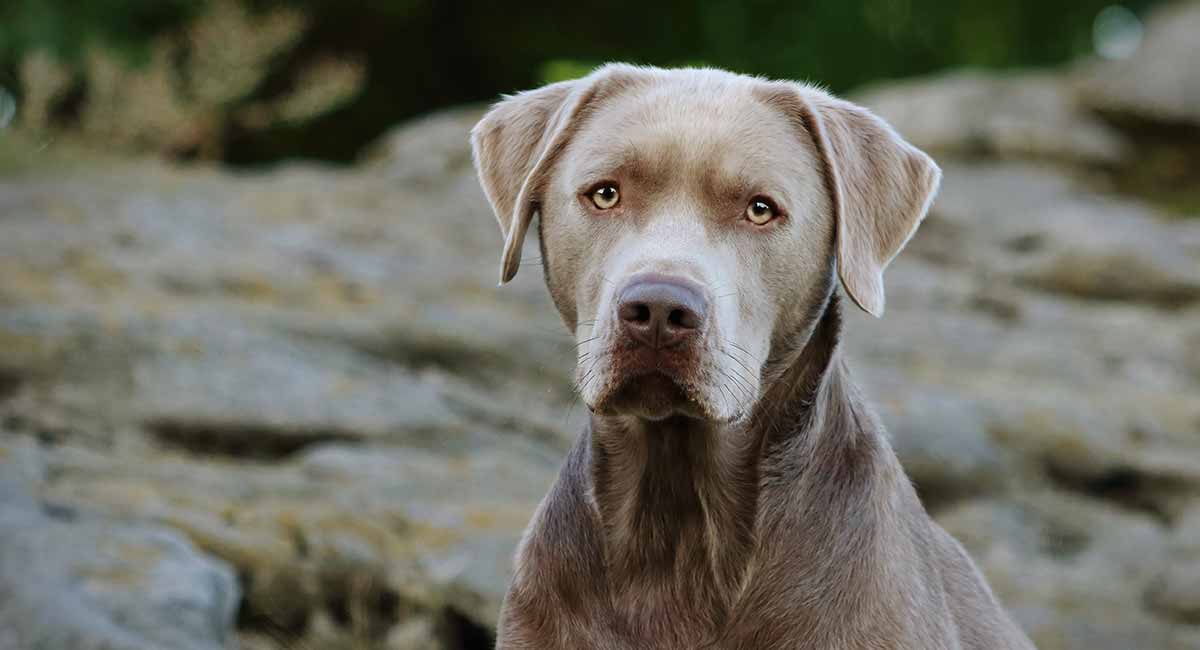
Many purebred dog breeders feel it is outrageous to charge large sums of money for dogs that are crossbred. And some view the silver Labrador Retriever as a cross breed.
Are silver Labs healthy?
Silver Labs suffer from the same health issues as other purebred Labs. Including a predisposition to joint problems and to over-eating!
Two studies record Labrador lifespan at between 11 and 12 years of age and Labs also have a higher rate of cancer (at 31% of all deaths) than some other breed
On balance, Labs are a fairly healthy and well constructed breed, free from the disabilities that plague some other purebred dogs. But there is a potential health issue associated with the coat color dilution gene which you need to be aware of.
Color dilution alopecia
The color dilution gene, that dd which gives us the pale silvery coat, is sometimes associated with coat problems. Specifically, it may be linked to a kind of hair loss.
The problem is known as “color dilution alopecia” and is more common in dogs that have the color dilution gene, dogs like Weimaraners, and now, silver Labradors.
It isn’t usually a life threatening condition, but it also isn’t curable. It can lead to progressive hair loss in young dogs and potentially recurrent infection in the hair follicles.
Thankfully, coat dilution does not always lead to skin problems. Not all dogs with the dd gene carry the faulty alopecia version and most silvers are, in fact, free from alopecia. In most respects therefore, silver Lab health is much the same as that of any purebred Labrador.
Ok, so we’ve covered what you can expect from a silver lab, and how they are both different from, and the same as, other Labs. Now it’s time to address the debate!
The Great Silver Labrador Controversy
Each time we discuss this topic on the Labrador Site’s Facebook page there is some anger expressed by those that are opposed to the very existence of silver Labradors. Though I do think that this is getting less over time, and that these dogs are becoming more widely accepted.
Reports of silver Labradors seem to have first appeared in the United States in the 1950s. Culo Silver Labs was one of the early kennels to produce this new silver color. You may be interested to read this report of an interview with the owner Dean Crist giving his account of the history of the silver Lab.
Much of the debate is focused on how the dilute gene that causes silver fur, got into our Labs in the first place. There are actually only a few options that can explain the appearance of a new gene in a purebred dog. We’ll look at each of these in turn
- mixed breeding
- spontaneous mutation
- hidden genes
The first explanation is that at some point, an outcross occurred, between a Labrador and a breed of dog that carries the dilute gene. A Weimaraner for example.
#1 Mixed breeding
The argument that silver Labs are not purebred, is quite a popular one. Many people believe that the first silver Labs were crossbreeds.
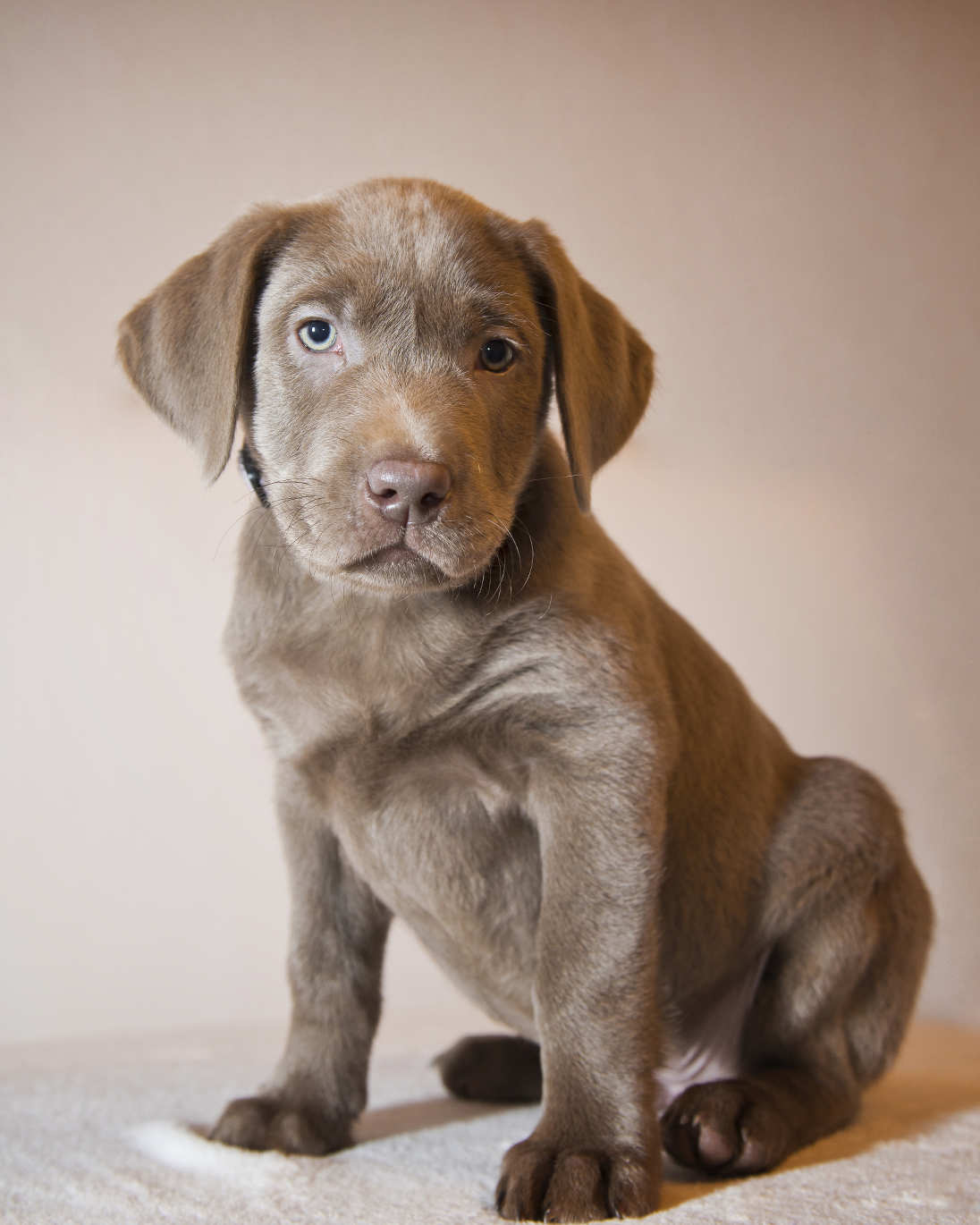
The theory sounds plausible enough as there are clear motives for dog breeders to create a new color variation in an existing breed.
Motives could include financial gain (though breeders couldn’t have known initially how popular the color would be), attention, or just the sheer fun of creating something new.
Diane Welle of Blue Knight Labs does not go quite so far as to directly accuse the breeders concerned
She wrote:
“There have been accusations that these “rare” silver Labradors are actually a cross between a Labrador and a Weimaraner. I will let you be the judge, as there is no evidence at this time, one way or the other. However, it is interesting to note that Silver Labradors can be traced back to two breeders. Those breeders are Dean Crist (Culo) and Beaver Creek Labradors.
Both of their lines trace back to Kellogg kennels (LE Kellogg and Harold E Kellogg) Kellogg Kennels began breeding Labradors in 1922. Guess what else they’re famous for breeding? They’re credited for the ‘rare’ pointing Labrador of course!”
Her point is that ‘pointing’ is, of course, an HPR (hunt point retriever) trait, and Weimaraners are HPRs. An update to her original article, however, also notes that she previously claimed that Weimaraners were also bred in those same kennels, but found out that that fact was in doubt.
Those in favor of the Weimaraner outcross theory often claim silvers have a houndy look about them. To be fair, this is true of many field-bred Labradors of any color. And most silver Labradors today look pretty much the same as any other Labrador Retriever – apart from the fact that they are silver.
The cross-breeding theory has recently lost some credibility due to genetic testing of silver Labs, which has so far failed to show a link to Weimaraners.
#2 Spontaneous mutation
It is not uncommon for genes to mutate. And a spontaneous genetic mutation is another way that a rare or unusual characteristic can appear in a family of dogs that were previously unaffected by it.
This isn’t a popular theory for the appearance of the dilute gene in the silver Labrador. Partly because the other two explanations are both so plausible.
And for a mutation to be identical to a gene that already exists for an unusual coat color in another breed would be something of a coincidence. Many people feel that the spontaneous appearance of this dd dilution gene in the Labrador Retriever gene pool is, to say the least, unlikely. However, it cannot be entirely ruled out.
# Hidden genes
Some people argue that the rare dilute gene has been present in Labradors all along, and that it only appeared, as rare diseases sometimes do, when two closely related dogs were bred.
The capacity of “rare” genes to remain hidden for long periods of time is a phenomenon that most scientists are aware of. This explanation for the appearance of the silver Labrador in the 1950s is perhaps the most valid alternative to the mix breed theory.
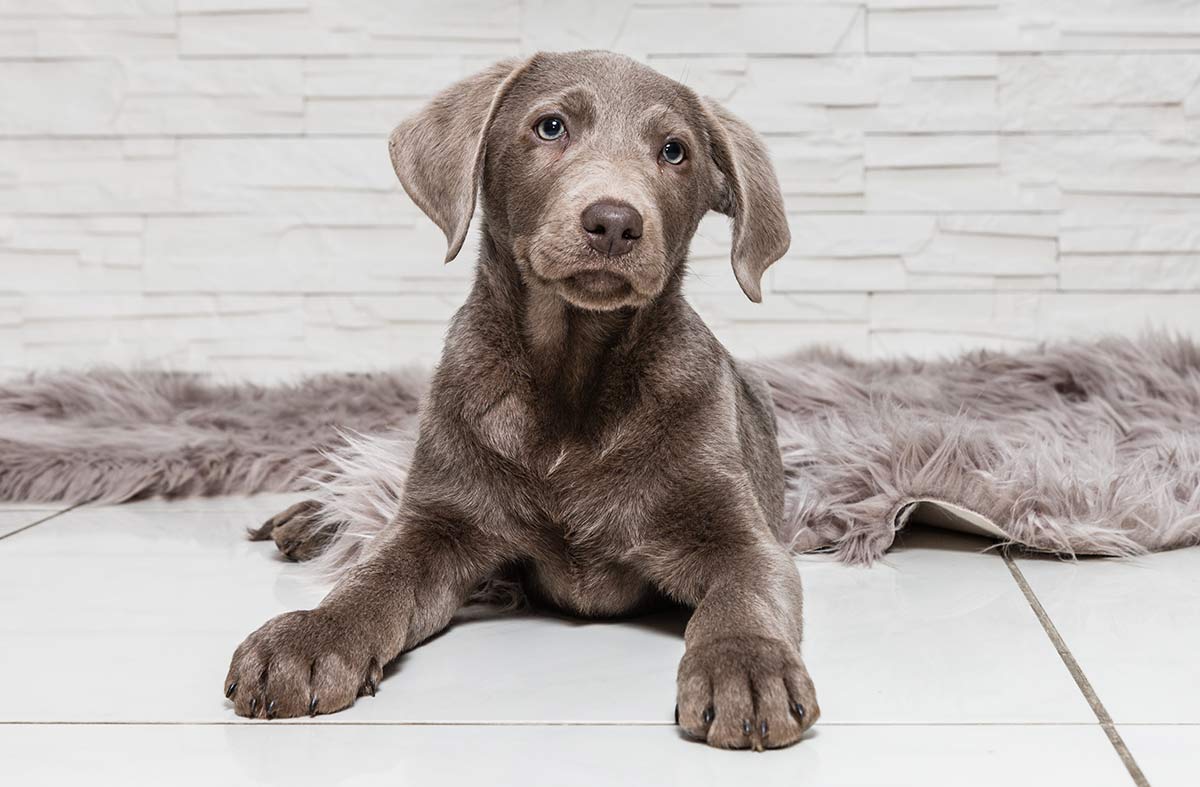
Genes carrying rare diseases or indeed any rare attribute, can remain hidden for decades, only to appear when closely related dogs are mated together. This happens more frequently when gene pools are small, as they are in our pedigree dog populations.
A good example of how that works is B color gene in Labrador. This gene determines whether or not a Lab is basically black or brown. Brown is recessive, just like the color dilution gene, and a Lab needs two copies of the little b brown gene to have a brown coat. And brown labradors only became common when breeders deliberately set about mating them to one another.
The first Labradors were not registered by the AKC until 1917. Before then there would have been regular outcrossing with other similar breeds. Including the Chesapeake Bay Retriever, a breed that does have the dilute gene.
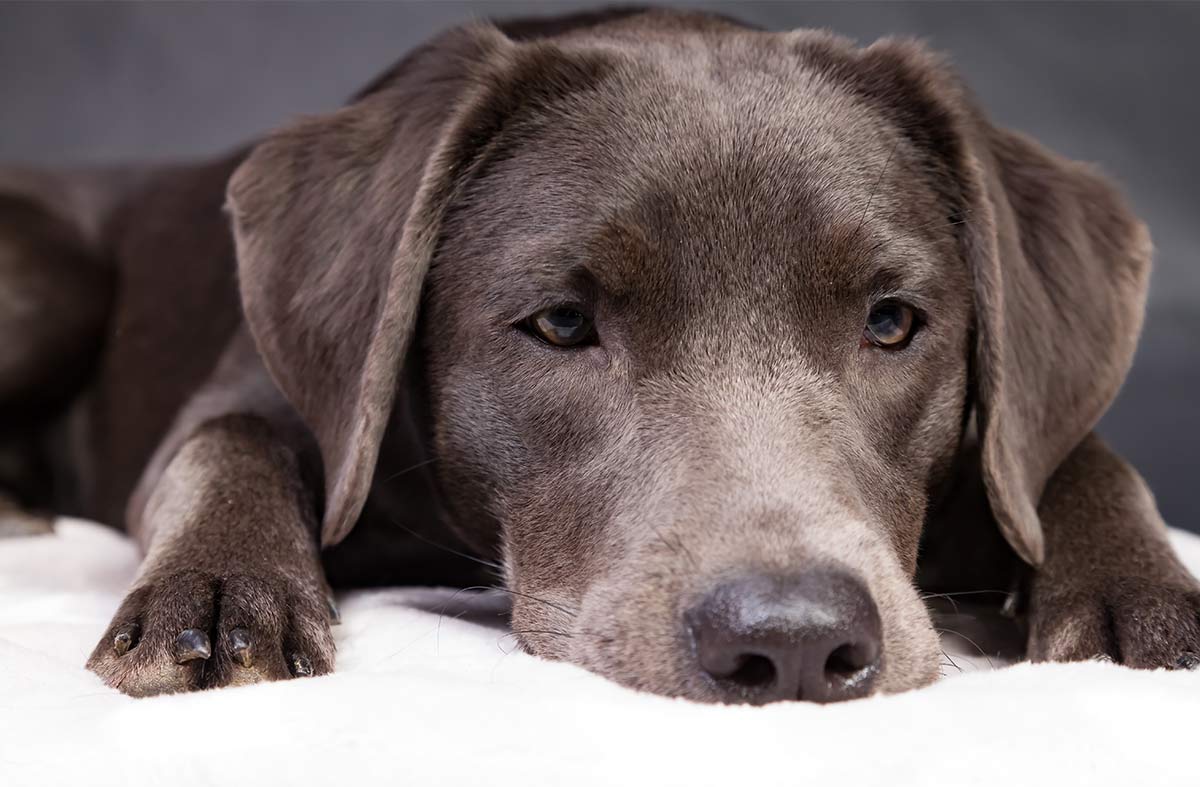
So it is entirely plausible that the little d gene passed from Chesapeakes into one or two Labs before the Labrador pedigree registers were closed and remained hidden in the breed only to reappear in the 1950s when the demand for Chocolates was beginning to rise.
Does It Matter?
Some of you will be bemused at all this fuss over a color. And wonder why it really matters how the silver color got into the Labrador breed. And to some extent I share that view.
I breed rabbits, and with purebred rabbits it’s very common for new colors to be recognized from time to time within established breeds. There are protocols controlled by the American Rabbit Breeders Association as to how this happens, but it’s generally seen as a beneficial and interesting event, not something to be afraid of.
Why it should be considered so radical to do the same in a breed of dogs, I’m not entirely sure!
Of course, most Labrador breeders care very deeply about the future of their breed. Some are concerned about the impact of accepting a genetic change in their beloved breed, without what they feel to be proper consideration.
They are angry at what they see as a dishonest Trojan horse operation to sneak what may be an outcross into the breed line. Pedigree breeders are also commonly committed to the concept of closed registry breeding. And are alarmed at what they consider a threat to the purity of the breed.
Concerns about inbreeding
Some breeders are also concerned about inbreeding in silver Labs. Inbreeding is always a potential problem when breeding animals within a closed gene pool such as our pedigree dog registers. But the problem is made worse when focusing on a small part of that gene pool such as a particular color.
It may be that inbreeding in silver Labradors will not be the problem that it once appeared to be. Former Labrador breeder Jack Vanderwyk, a vehement opposer of silver Labradors, conceded in 2012 that:
Today, in 2012, many, many generations later, the ‘silver’ Labrador population has a fairly viable gene pool, with seven distinct, (almost) unrelated lines. As a result, the average COIs (Coefficient Of Inbreeding) are often not higher than those of other Labrador lines. This means that we shouldn’t underestimate the ‘silver’ population.
It is worth remembering that any risk of inbreeding can be reduced by ensuring a low co-efficient of breeding between the parents of each litter. A knowledgeable breeder will be able to help you with this.
Puppy mills and backyard breeders
There have been concerns that many silver Labrador puppies are irresponsibly bred by backyard breeders or in puppy mills. These concerns can of course apply to any popular breed but are more of a worry when a particular cross breed or color variation become so popular the prices are driven up and less scrupulous breeders try to cash in.
But as silver Labs become more mainstream, there are clear signs that responsible breeding practices are being adopted. And it is certainly possible now, to buy a silver Lab from a reputable breeder
Pros, Cons, And Buying Tips
One of the downsides to bringing a silver Lab into your life is that you may experience unpleasant reactions from those that think silver Labs are ‘ruining the breed’. Or who believe that they should be banned. The comments and social media posts can sometimes be very hurtful
Cons
- Some people may be rude about your dog
- You won’t be able to compete your dog in the show ring
- You may have to pay a higher price than you would for a regular color Lab
- It might be harder to find a responsible breeder in your area
- There may be a small risk that your dog will get alopecia
Pros
- Your silver Lab is likely to have the health and fitness of any other Lab
- This Lab will be as lovable and trainable as any other Lab
- Your Lab will probably be a great family pet
- You will have the pleasure of owning an unusual and beautiful dog
There are questions regarding the registration of silver Labs born in the future. You should be aware that there are people campaigning to have silver Labs de-registered.
Should they succeed it could affect those who want to breed from their dog, or who want to compete with their dog in obedience or field trial competitions that are only open to registered pedigree dogs.
Tips For Buying A Silver Labrador puppy
If you decide to bring a silver Lab puppy into your life, it is very important to find a responsible Labrador breeder.
You’ll need a breeder who health tests all their dogs before breeding, and whose dogs are a part of their lives, not just breeding machines.
Happily, breeding silver Labrador puppies is not mutually incompatible with being a responsible breeder. But you will need to be diligent in order to avoid puppy mills and bad breeding practices.
Silver Labrador puppies should only be purchased from breeders that have tested the puppy’s parents for hip and elbow dysplasia, PRA (inherited blindness) and CNM (a muscle wasting disease.
Remember that a silver Labrador, if registered with a kennel club, will be registered as chocolate. Check the pedigree and health certificates very carefully.
You can find out more about how to find a good Labrador breeder in this article.
Your Silver Lab
If you share your life with a silver Lab, we’d love to hear about them, and about your experiences in finding him or her. We’d also be interested to know if you have experienced any prejudice against your dog because of his unusual coat color.
We love to hear from our readers. So whether you adore silver Labs or oppose them, your politely expressed views are very welcome! Just drop them into the comments box below.
Let us know what you think and why!
References And Further Reading
- “Purebred Vs. Mutt,” The Labrador Site, 2019
- “Dilute Coat Color D-Locus and New D2-Locus,” Animal Genetics, 2019
- “Dilution D Series,” Dog Genetics
- Welle, M, et al., “MLPH Genotype – Melanin Phenotype Correlation in Dilute Dogs,” Oxford Academic Journal of Heredity, 2009
- “Q And A With Dean Crist,” Silver Labs – Just The Facts
- Welle, D, “No Such Thing – Silver Labradors,” Blue Knight Labrador Retrievers, 1990
- “Breed Color Position Statement,” National Labrador Retriever Breed Council of Australia, 2010
- “Silver Labs,” The Labrador Club of New Zealand
- “What’s In The Gene Pool?” Institute of Canine Biology, 2017
- “How Population Size Affects Inbreeding,” Institute of Canine Biology, 2017
- Wagner, S, “The Truth Behind ‘Silver’ Labradors,” Woodhaven Labrador Retrievers
- Hered, J, “A noncoding melanophilin gene (MLPH) SNP at the splice donor of exon 1 represents a candidate causal mutation for coat color dilution in dogs,” 2007
- “Color Dilution Alopecia,” Animal Dermatology Clinic, 2010
- Philipp, U, et al., “Chromosomal assignment of the canine melanophilin gene (MLPH): a candidate gene for coat color dilution in Pinschers,” 2005
- Philipp, U, et al., “Polymorphisms within the canine MLPH gene are associated with dilute coat color in dogs,” 2005
- “Silver Labs – Improvement Movement,” Silver Labs Blog
- Zeirath et al Frequency of five disease-causing genetic mutations in a large mixed-breed dog population. Plos one (2011–2012)
The Labrador Site Founder
Pippa Mattinson is the best selling author of The Happy Puppy Handbook, the Labrador Handbook, Choosing The Perfect Puppy, and Total Recall.
She is also the founder of the Gundog Trust and the Dogsnet Online Training Program
Pippa's online training courses were launched in 2019 and you can find the latest course dates on the Dogsnet website

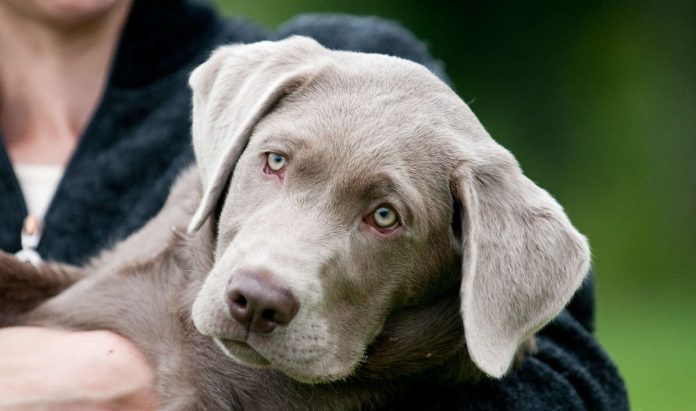
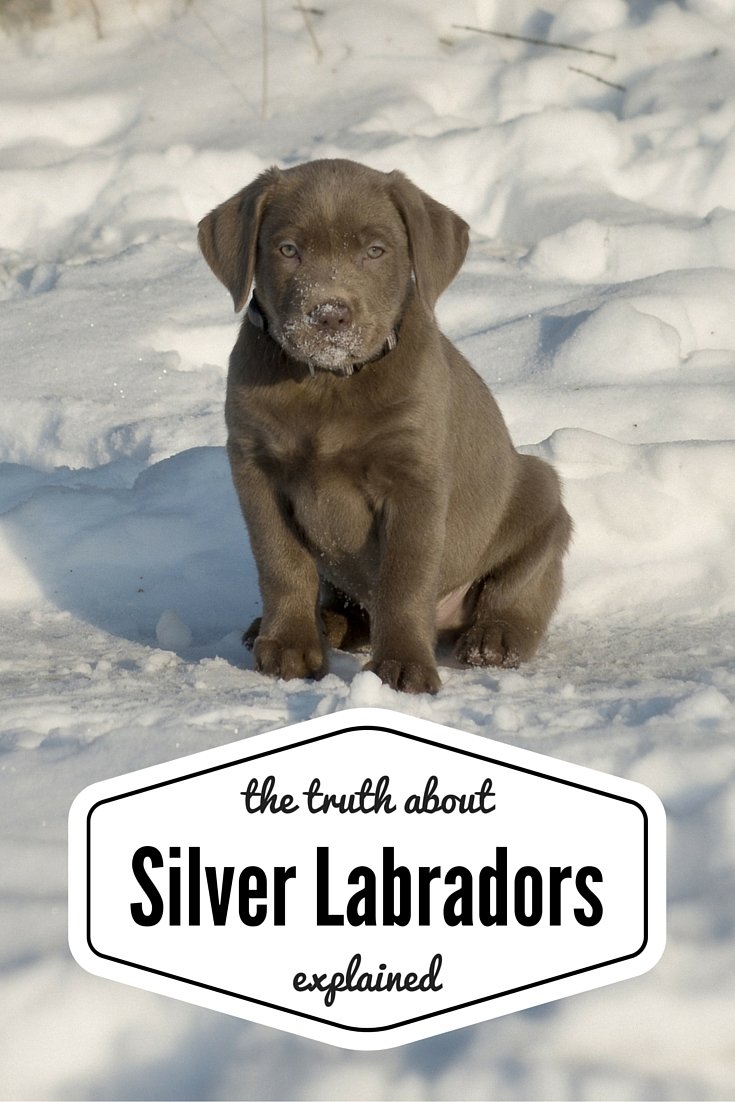
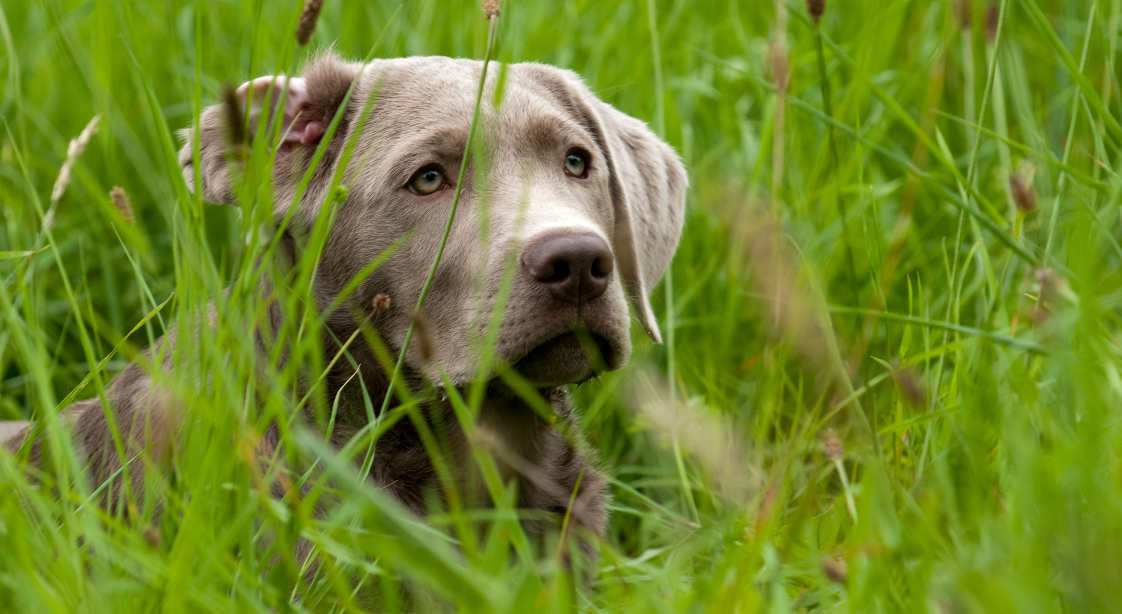
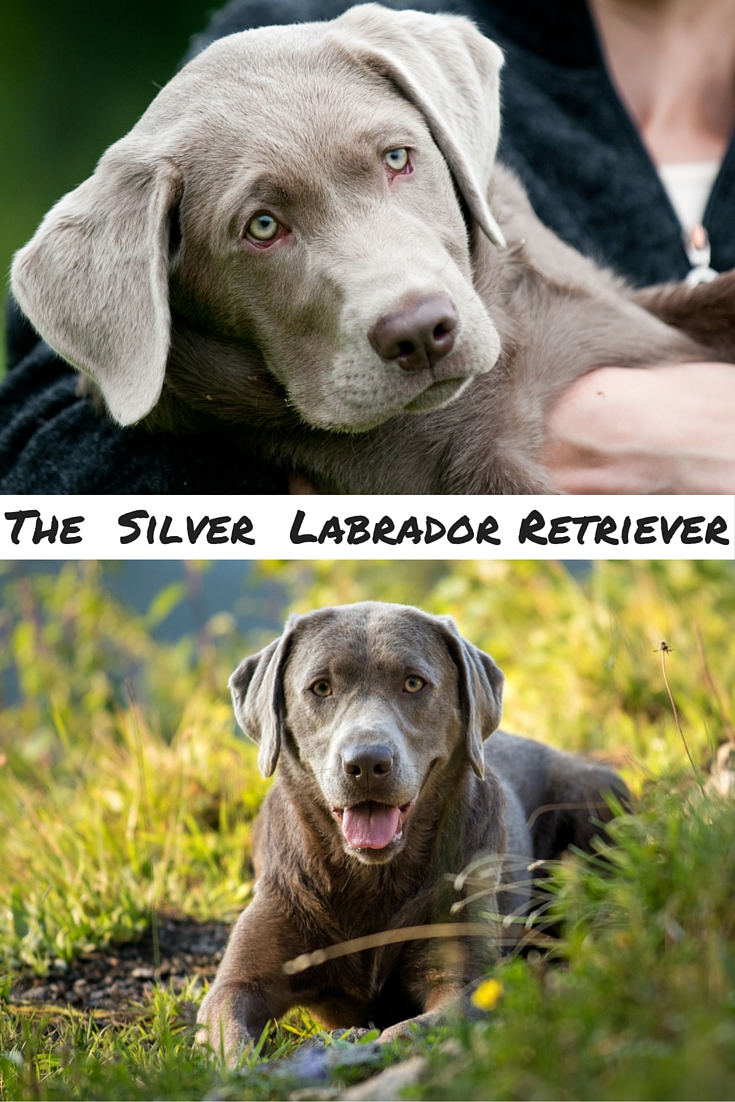

















I don’t have a Lab, I have an American Staffordshire Terrier, she looks like a pitbull only she’s taller and her head is smaller. I get three different reactions from people when they see her; either they think she’s absolutely gorgeous (which she is for her breed, I get a lot of requests to breed her), they’re afraid of her or they hate her right off the bat. If it’s the latter then people can get really mean, not only towards my dog but towards me directly, I sometimes hear choice words directed at me or even both of us. I can truly understand the harsh negativity you guys have to deal with. My girl is 14 so I don’t have a whole lot of time left with her, when she passes on I’ll be getting a service dog. I have medical issues that warrant getting a service dog and most svc dogs are Labs, I would be just fine with a silver, it’s unlikely that I’ll get one but I’d still be happy to have one.
Every dog in this world is important, special and deserves to be loved regardless of what it looks like. This hatred towards Silver Labs, to me, is not much different than racism. Discriminating against a being because of what it looks like is wrong and you should be ashamed of yourselves, plain and simple. Don’t you think there are better things you can do with your time than worry about what colour the puppies are that this breeder is selling or if that persons Silver Lab is really a Lab? Come on people get on with you own life and stop worrying about what other people are doing! Hi5 to all you true Lab lovers, silver and all.
I have a new puppy who is an absolute darling and to be honest who really cares whether or not he is crooked with a Weimaraner at the end of the day is a dog that deserves loving. This has happened every time a new Labrador colour is introduced they take a while to be accepted why is it that we are not mature enough to realise this yet. I understand they can effect breeding lines but this suggest a recessive gene so it is no ones fault it is very typical of us to try and blame someone but in this case it may well be a gene and therefore I am asking you to be polite and not offend silver Labrador owners as it is not there fault you are small minded and not open to the fact that silver labradors are like any other dogs. In fairness I understand they might be cross breeds but in no way does that make me love them less as there are billions of children cross breeds plenty of which are subjected to the same abuse. All in all I pity your small mindedness and I hope that this is a trait you can lose.
I have a beautiful black color labrador dog and i love my dog
I have a silver female if I breed her with a yellow male I should get some or at least one silver pup shouldn’t i
I have an awesome silver Male and I have never had a lab with a nose like this silver lab, dude is a natural.He hates geese though, he will retrieve them but doesn’t like too. His brother is black and is whistle trained and they hunt well together, silver just out performs him on a regular basis. Either way great hunting buddies and hunting and retrieving machines. So far health has not been an issue and I my silver came out of Iowa.Both parents were silvers.
Josh, probably none. Assuming the yellow is not a dilute (a.k.a. champagne) the only way to get any silver pups would be if the yellow carries a “d” (dilute) gene and carries chocolate. Given the relatively easy access to DNA testing to determine whether a dog might pass along genes for serious medical conditions, such as EIC, you should never breed two dogs who haven’t (or whose parents haven’t) had DNA testing, as well as hip and elbow X-rays. So if you’re being a responsible breeder and getting DNA testing for medical conditions, you can simultaneously take the guesswork out of color possibilities by looking at DNA results for which colors are carried.
What kind of DNA testing do you want posted? I have a silver male that has had the required DNA testing through AKC after breeding so many times. Is this the kind you want or more specific?
In this instance we’re talking about breed testing or profiling Rima. Not health tests, but rather evidence of parentage.
I really enjoyed this article. I ve always had Labs. I had Choccy ones when peopled looked at them and them funny or strange ! The amount of people that asked what they were and had not seen 1x before was unreal !
The fact is I love my dogs and would have a silver 1x tommorrow no matter what anyone thought. Is not that what having a dog is about ?
We have a stunningly wonderful Silver Lab (Chocolate base) that is 3 yr old. She is the smartest dog we have ever owned, and has been a joy. She is very alert and would be a good field dog (if I hunted). We have had several people tell us “let us know if you breed her, she is wonderful!”. I have had her OFA tests (all Good/Normal), as well as EIC (n/n). We have run into the occasional snobbish comment at her picture on Fb by “show” people who are determined that the only Labs are Black/Yellow and maybe Chocolate, and have also run into a very unprofessional behavior at our large animal hospital by a Vet Lab tech who happens to show labs, and filled out paperwork incorrectly on purpose so that we had to do the testing twice! I don’t ever breed any animal without proper testing, training, and making sure they are all positive attributes to pass on — or don’t breed. I am hunting for a male who would be a compliment and improvement to the Silver breed with our girl potentially. We love her to pieces and are very proud of her. I did run into one lady who also shows Labs and when she saw my girl’s picture – said “WOW – you really have something gorgeous and special there!”. I am so much more concerned with conformation, functionality, personality and trainability than I am “color”. I just happen to be drawn to the grey in all of my animals (cats, dogs, horses, goats)….
hello laura, we are a family from germany with two boys (4.5&7 yrs old) and would love to complete our family with a fifth family member, we would like a family dog. my husband grew up wirh gordon setters, but they are too prone to hunting for me, and this is why we have settled on a (silver) labrador. our timeframe is two years, we would like to learn about many things one needs to have considered, spoken and thought about beforehand, and we would like to grow in terms if responsibility, understanding etc in preparing to giving some new household member a safe place with us. pls, if you have any input or experiences of your own to share with us, do get in touch, or, if we may contact you in case of questions from our side, pls do let me know how we may reach you. if this request is too much, pls ignore…
thank you in advance and best regards, gabriela broja
My neighbor, in a fenced yard, had an AKC registered English Bulldog that came in heat. 1/2 a mile down the road, a different neighbor, fenced in yard, had a full blood AKC solid black lab that jumped fences. I think she had a total of 5 puppies. All solid black and looked just like a lab. My children didn’t care about what breed they were, they fell in love with the puppies so we had to keep one.
That female puppy is over 2 yrs old now, very smart, and you couldn’t tell her apart from any other full blood lab standing right beside her. She is solid black with a little white spot on her chest.
During her heat cycle, she escaped her kennel one morning and apparently found a mate. The only fertile male dog around for a mile in either direction is a small looking black lab mixed breed. But he looks full blooded, just younger maybe on the small side compared to her. Solid black with white on his chest.
So now we have 13 puppies. 4 black with white spots on the chest. 2 chocolates, ( 1 dark chocolate, 1 lighter colored chocolate). And 7 silvers. The darkest silver colored one, although plainly silver, I can see where it thought about being a chocolate color and changed its mind at the last possible second.
Now I’m not claiming we planned this breeding, but it happened and I will find good homes for all the pups we don’t keep, that’s not why I comment on this post.
I did not know, silver was a color for a lab until I found this post, and to my knowledge it is certainly not a color of English Bulldogs, which is why I am searching the web for explanations of where this silver came from. All of these puppies, although not registered and are technically mixed breeds, for all practical purposes they are plainly labs. With the 4 black ones and 2 chocolate ones there is no denying the Labrador dominance in these pups. So silver must be a trait in this bloodline of Labrador and whether it came from someone cross breeding with a weimeraner 100 yrs ago or not, when I first saw these pups colors, a cross with weimeraner is what I first thought of to. So its not that far fetched to believe. Its hard to imagine however far back up the bloodline it may go, that breeding 2 black labs could produce silver. I truly didn’t know what to expect, but even chocolate I did not expect from 2 black labs so a silver was way out there for me, especially with English Bulldog in the mix however minute it is, it is still there.
I don’t show or breed dogs, I have a pet and that’s what I wanted. I do believe in the value of purebred dogs and keeping a bloodline pure and in planned and researched breeding for quality and health, but I also see the value and benefits in owning a silver Labrador as well as I didn’t know they existed but now I want one. I wish they could compete in sanctioned shows etc, even if you have to register them as a different breed. Color does not determine quality and they are still Labradors with the registration to prove it they should be aloud to compete.
All pure breed dogs were crossed, mixed breeds in the beginning and bred for a specific purpose and or look. There are constantly new breeds in the making from old breeds everyday. Has been since time began and will be till time ends
Can I ask if you have found homes for your dogs. My son and fiancé are interested in a silver lab pet. We are in PA… are you close? Thanks…Ava
Hi John, Do you still have any silver puppies left? My English lab is is turning 9 and I’m thinking of getting a puppy to keep him company and to bring fresh new mischief into our lives. I’m in New Jersey a across the river from Philadelphia. Thanks Yvonne
Good day, John,
Years back I had a Chocolate Lab named “Blue Eyed Butler from Belle”. I have always loved the breed since then, and have been on the look out for another Lab. As gray is my favorite color, I had been searching for a silver or gray lab, or mix. Do you happen to have any gray pups left, and if so, are you anywhere near Oklahoma?
My family use to breed field trial/hunting labs, an ex boyfriends family use to breed show labs, and I now have a house lab. To be these silver labs don’t look like any of the theee different ” kinds” of labs I’ve seen before. To me all the pictures I have seen they look more like weimaraners. Ok maybe not MORE like Weimaraners but they definitely looking like they have some in their blood. Over seen a couple pictures on line and a few in real life and every one of them seems to have a shorter tail and those Weimaraner eyes. Which I’m not saying is bad. I’m fine with mixed breed dogs but you can not label them as one breed or the others
Interesting article. I have a lab mix that is silverish. He looks all Lab except for his coloring. I call it Charcolate because depending upon how the light hits him, it can seem brown sometimes but mostly he looks gray. His mother was a Black Lab and dad was a Pit. He is the most beautiful dog and I can’t take him anywhere without people asking me about his breed. Unfortunately he’s been diagnosed with Lymphoma which we caught by chance, Quite surprising for a 4 year old but had no signs of illness. He is in 2nd week of chemo and still acts like a puppy. I love this dog, I imagine these Labs have some kind of breed mix in them to make them this grey color.
Labradors should be black or yellow.
People who desire anything else are just looking for
an accessory to compliment themselves.
I don’t think it should matter what color they are. Labs and Lab mixes are great dogs. Anyone who insists on a purebread anything is selfish and just wants an accessory period.
I last I knew Andrea that’s what all purchases and decisions people make are based on. Ie what suites my needs wants and desires the best and most efficient. are you getting some that all up are you getting some that all up into one word accessorize. Anyway isn’t that what life is about surrounding and accessorizing yourself with what makes you feel the best and enjoy your life the most because I’m very positive and sure in what I’m about to say to be true on your part and that being I’ll bet you didn’t just go out and buy any old car Rusty new used Ford Chevy Dodge you hunted around until you found the exact color make model and accessories that you wanted to be accessorized with because as we all know who what and where you surround yourself with is there a non vocal way of expressing ourselves and Who We Are to everyone else. I know this is off subject but my favorite Mustang is the 1976 Cobra 2 like Farrah Fawcett from Charlie’s Angels many Mustang enthusiast try to tell me and make fun of me and say that isn’t a Mustang when we all know sure it is I have happened to own almost every different body style Mustang there is but by my desire and accessorizing is my choice and favorite just fortunately I’m able to send a lot of them critics home with a loss under their belt buy that none Mustang mutant that they call it so a good majority of the time I get the last laugh
My wife loves dogs and hates dog hair. Previously we have had two yellow labs and their shedding shows terribly on dark furniture. It came time to get a new puppy and being that our furniture and flooring is Gray we toyed with the idea of a Weimaraner, but really LOVE Labs. One night while surfing the web I stumbled across Silver labs…. the PERFECT answer to our family’s needs. We purchased “Alaska” from Barb’s house of Labs in Arizona and are quite happy….except when she does some naughty puppy stuff. We always LOVE her. Out in public, her color does make her a conversation piece which is fun. I think more colors is like more flavors of ice cream. It’s a very good thing.
I’m not really sure why insertion of Weimaraner genes into the lab blood line, if it at all happened would be an issue, as long as it was done honestly. Let’s remember that all pure bred dog breeds are the product of mixed breeding programs targeted towards both a desired composition and temperement. This always happens before standardisation. Labradoodles and the like are again the first steps towards the standardisation of new breeds. In the end it’s the wellbeing of the breed that is most important. If a bit of outcrossing every now and then can help maintain breed health and longevity without totally compromising the look and behaviour of the breed, to hell with purity. It’s all for the best in my opinion.
No it is not the only reason y u get a mixed breed dog or what I call a mut is because u c one dog n think o g I want that then u c anther one n think o g I want that one two then u think hey y don’t I breed them n I will have one of both n the same dam dog n that folks is what I call a mut labs no matter what color they r they r pure breeds they r not muts I have on as my service dog n he is awesome he is 5 months old smart as a whip does everything I ask when I ask n never let’s me down he is a pure breed I don’t know what I would do without him
who cares if they comes in black, yellow, chocolate or purple, I love labs in any color
Thank you Pippa, this is a very informative, unbiased article that presents all for and against information regarding silver labs.
I have a loving smart silver lab. I’ve been verbally attacked by random strangers. People came over and examined her to make sure that she is really lab – like webbed feed and the distinct scent. Its quite odd watching people smell your dog :). The thing is … aside from her color, she is 100% lab in her personality. She is playful, energetic, loves our cats and pretty much everyone she meets.
Thanks for your kind comment Alana, and sorry to hear you have experienced unpleasantness towards you and your dog. 🙁
Totally agree with Keenan T. I have a 9 month old silver lab and this has been the smartest and prettiest labs I’ve owned so far.
When breeders choose to breed for silver, is it unwise to breed silver to silver? I know that in most breeds that have Merle coloring, breeding two Merle’s is avoided for health reasons; just as white boxers are not supposed to be bred to another white boxer. Are there documented health problems from breeding silver to silver?
I love Labs and have had a chocolate and two blacks over the past 27 years. My present black Lab is a rescue, so I can’t be absolutely sure of her being purebred, but like the two before her, she is a wonderful dog who has added much joy to my life and exhibits most of the Lab traits that I love.
I have a sliver lab he is 8 months now, they’re just like labs just sometimes don’t get seen as full bred labs. Like people, stop it with this stuff they’re animals! Even though the AKC doesn’t see them as silver labs they clearly are! Mine is a full bred labrador retriever.
Hi Keenan. I’m looking to purchase a Silver Labrador, can you recommend the breeder you purchased yours from..? Thanks
I have a beautiful 8 year old silver lab. She is a lab in every way! Also AKC registered as chocolate. Everyone who meets her falls in love with her personality. The only negative comments I have received about her has been from posting about her on Facebook. Completely unfair because they do not know her or her breeding.
Lgriggs, do you also consider it dishonest when a fox red is registered as a yellow?
I want to have silver lab.. can anyone let me know where I an adopt or buy them
The answer to the silver labradors genetic debates seems obvious to me. Champagne and charcoal labradors have the IDENTICAL COLOUR DILUTION GENE which results in the silver. So the silver is not a result of subterfuge any more than the other dilute colours and has just as much right to it’s pedigree status. ALL dogs are biologically the one species (ie they successfully interbreed) and have a common ancestral gene pool. Then humans selectively bred dog populations over tens of thousands of years for certain traits, and more recently developed “purebreeds”. This selective breeding manipulated what would otherwise be the natural statistical occurrence of genotypes. In some cases only one colour genotype is found in a breed, in other breeds there will be multiple colour genotypes and multiple modifying genes, all with differing prevalence. As fashions change, breeding changes, thus altering the prevalence of genotypes within the breed.
Belyaev’s silver fox breeding program shows how quickly and dramatically rare traits (physical as well as psychological) can appear in a controlled breeding program.
Black labradors were prized and blondes and browns not bred from, thus artificially reducing the prevalence of other genetic variants. Add a low incidence of the “naturally rarer” chocolate, so an even rarer occurrence of the the dilute chocolate (ie silver). If it occurred at all. And I can imagine that before genetics was understood/provable a breeder would want to hide (destroy) such an anomaly in their bloodline, to protect their reputation. Then browns became popular, and selectively bred. No surprise that silvers popped out!
Interestingly a similar colour dilution gene exists in cats (Cream = dilute gene + Orange gene, Grey = dilute gene + Black gene) and purebred cats have faced the same arguments.
I have a 10 year old Charcoal Silver lab who we rescued or he rescued me. He is papered as a black lab. He is a very soulful dog and doesn’t act like a lab at all. No fetching, no swimming and absolutely hates guns. He suffers from separation anxiety, degenerate elbows, thyroid problems, congestive heart failure and sensitive to protein. He is the love of my life and loves his chiropractor sessions, vet visits and going for walks with me. He can’t walk fast or far theses days, but has the best life possible for a dog who lived in a crate for 9 months. I hope more and more breeders are responsible, I reached out to the breeder who sold a bunch of dogs to the person I got Tucker from to let them know of the health issues of their dog and got no response from them. 🙁
We got a beautiful, funny, smart, and exceedingly loving silver/grey Lab 2 1/2 years ago. He came into our family as an addition to our yellow Lab, Merlin, who is very true to form, AKC Lab ready “to show”. Mac is much taller than Merlin at 28″ tall. He is more vocal and more outgoing and at times drives Merlin nuts but there is no doubt in my mind or my husband’s that he is a Lab! He is no more a Weimeraner cross than I am. I just don’t think most people know what to make of him because of his color and the fact that he is probably even more animated than a chocolate Lab. All I know is that when he is out in the yard “greeting” families to the playground next to our house, he makes people smile because he always has a toy in his mouth! All he wants is love! We wouldn’t change our choice for anything in the world and as I write this he is resting his chin on my foot! What else can I say!!? My questions is – even our vet can’t tell us “technically” how much he should weigh. Currently, he weighs 116 lbs. but he is a big boy at 28″ tall. Does anyone have any idea?
Here’s the article you need Libby https://www.thelabradorsite.com/how-much-should-my-labrador-weigh/
I was a respected Labrador breeder of all colors for more than 20 years until I could no longer handle the stress from the threats that I received for breeding the “other colors”. These were most often from other breeders that think they know it all and judged me for not conforming to their beliefs. I eventually gave up breeding the “other colors” because I am too old now to have to deal with the stupidity that comes with something new being introduced to those that can’t accept change. All Labradors are the best, no matter what their color may be. Being a Lab breeder for most of my life, I can tell you that medical conditions are not based on a color. As breeders, it is our biggest hope that none of our puppies will ever have any problems but that is not LIFE. Prejudices due to color do exist in dogs as well as in people. It just boggles my mind as to why…..
I adopted a weimaraner lab mix from South Carolina. I like that he’s a mix because they are healthier. he looks mostly Weimaraner now at 6 months. He was in the shelter with his brother and I wonder what circumstances would lead to two puppies from the same litter being in a shelter. I hope it has nothing to do with that he is a dark or “blue” color, such that at Weimaraner breeder might want to get rid of him, or that he is “silver” lab, such that he might be considered undesirable by a lab breeder. He is adorable, sweet, playful and a joy. Who cares if the AKC doesn’t have a place for him?
Great article Pippa. My son and I had to put down our 6 year girl Pepper on Valentine’s Day and we are so broken hearted it’s so hard to do anything. She was the most beautiful silver and so extremely smart, loving, laid back, and was my soul mate. As another commenter said…she did know what I was thinking or how I felt as I am disabled and she learned to become an alert dog for me all on her own. She was so beautiful but at around 2.5 developed hypothyroidism and lost most of her hair and her skin got dark. A year ago she quickly developed severe diabetes and went blind in one week which we got back quite a bit of her eyesight after we got her on insulin. Over recent times she kept lifting up her right leg liked she stepped on something and started going potty on the floor more and more….realizing when she needed to go out it was right now. We miss her so dearly and my heartache has now turned to anger but thankfulness to the breeder because she was so amazing but most of her life didn’t likely feel like a dog. I plan on trying to get ahold of them and wonder what I could or should do to report her AKC bloodlines so others don’t have to experience this pain. If anyone has any advice I would so greatly appreciate it. Thank you. I love you Pepper to the deepest part of me and miss you in an unexplainable way…but I know you’re still watching me all the time as that is what you committed your life to from the day we met! ♡♡♡
My silver lab has black patches on his tongue, is this normal
Hi Linda, it’s unusual but plenty of labs have them, here is an article about black tongue spots https://www.thelabradorsite.com/black-spot-on-dogs-tongue/
I have a 6 month old Silver Lab named Charlie. He is registered as a Chocolate with the AKC and we have his pedigree going back six generations. All Labs ;). Since we have had him I have only had one person make a negative comment about how he “isn’t really a lab”. Everyone else that sees him comments on how sweet tempered and good-looking he is. He is a great dog and I would suggest anyone looking for a pet to consider a Lab ( of any color ).
I have a 15 months old silver Labrador named Kashmir. He is pure joy and my everything. Thank you for the article
I just purchased a beautiful Silver Lab puppy from the breeder where I have gotten all four of my previous labradors (three yellow, one chocolate) They started their silver line three years ago, and through careful and responsible breeding have only just had their first litter of silvers (actually five silvers and three chocolates). My new puppy is sweet, smart, energetic and will no doubt turn out to be a beautiful, loving companion. I wish I could figure out how to post her picture.
Can you recommend a Silver Lab breeder in the UK please? We would really love one. We already have a Chocolate Brown Lab and a Black Lab. Just not sure where to begin looking!
I have a silver 4 year old lab, Emmie Rose, she is the best and most loving dog I have ever seen or had. Her personally is the sweetest and she is super smart. It is like she knows what your thinking and does exactly what she should do. She is in good health except alittle over weight. She is really big boned and very tall. Best lab ever.
I have a 2 yr old silver lab that came from a litter of 11 silver pups. The mom and dad were both silver. I have had all colors of labs, this is my first silver. He has a lot of energy and is extremely smart. He has become my best bud since my husband passed. His name is Grey Goose, I call him Goose!
Hello I had a silver lab named Bodie who only lived 5 years. When he died my heart absolutely broke. He developed cancer in his ear which eventually spread to his stomach and paw. He developed grand mal seizures which were terrifying to watch. He was my best friend and I loved him with every ounce of my exsistance. He was my second lab and now I have a female yellow lab named Penny. I now have back the love I shared with my previous two labs. Unfortunately I would not recommend a silver lab to anyone. Both parents were silver and on premise. Good luck and I hope all who have a silver enjoy them for many many years.
PS Great article…forgot to say that!
Thank you 🙂
Anybody (in any breed) breeding dogs for appearance only is doing a disservice to their breed. Period. If silver is a weird color that pops up every now and then in Lab litters, so be it. At least the breeder won’t kill the puppy because it’s a mutant if there are folks who would love a silver Lab. (yes breeders used to kill rejects…maybe some still do…hope not) My fear is as it becomes a “cool” “rare” color, people will start (if they aren’t doing it already) crossing Weimaraners and Labs in order to get more silvers per litter. Guess money changes everything…. But I can’t say it enough… breeding for appearance only is why American Cockers became somewhat nasty in temperament (not at all their original natural state), all the Setters lost a lot of their natural intelligence, and Quarter Horses (happens with other animals too) started falling over for no apparent reason. Form follows function…crossing breeds for function is how all the breeds evolved in the first place. Let’s get fashion out of the breeding equation.
Unfortunately, there are people out there crossing weims and labs together to get more silvers. But there are also breeders out there only breeding labs together. You have to be careful when your buying a silver bc of this reason.
I have a question. I see that traditional lab breeders seem to mostly have a problem with silvers. Why don’t they have as much problem with champagne, fox red, white, and charcoal? Don’t all dilutes carry the dd gene? Thank you for your input!
Hi Mary, Champagne and Charcoal are dilute genes. Fox red and white are just shade variations produced by the standard yellow gene combination, not dilutes. I suspect that Champagne and Charcoal are not frowned upon as much because they are less common and less obvious than the silver Labs, but this would be a guess!
What is all the fuss about colour?? Labs are still the best breed ever!!!
If CKC’s are that worried about the silver ones looking like weimaraners, they should stop trying to breed out the big square “old-school” blockhead that labs used to have – the smaller slimmer head looks out of place on some dogs and combined with the silver colour, they do look like the other breed.
In a litter our two purebred labs produced – only one pup inherited the father’s big head and all others inherited the smaller slimmer head of their mother. The one who inherited the big head is the best looking one of the lot and we receive many comments on his handsomeness. In my experience of owning and training Labs for 20 years or so, the ones with the big blockheads seem to be more confident and calm and easier to train, the ones with the smaller heads seem to be more anxious or flighty and harder to train.
Maybe CKC should concentrate on the important things like ensuring the eradication of elbow and hip dysplasia, and let the colour be what it is – it doesn’t change the nature of the dog, or the integrity of their owners, just the perceptions of some narrow-minded elitists.
Labradoodles have been accepted as a separate breed – if they can prove cross-breeding, then so be it – declare them a separate breed as well and let it rest.
I have a beautiful day silver lab that we rescued four years ago. He and a female had been purchased by a family who wanted to try to breed them. However, the female ran away before they were mated. The family split up and wanted to get rid of some of their many labs. We had lost our two chocolates the spring before and found out about Hank. He is a wonderful dog and totally devoted to me. What you have said about the dogs with the smaller heads was very interesting to me. Hank’s head is small enough that it is difficult to keep a collar on him. When they were younger our black lab mix pulled his collar off frequently. Other things you said also fit Hank. He has been a very anxious dog ever since we got him. He paces and whines if there is a closed door between us. If I leave the house he paces and keeps going to the door to see if I am back. He does the same thing if one of the family members or one of the other dogs is outside. He is my shadow, and whenever I turn around he is right behind me. He has fears of several things but one is the wind. If it is the least bit windy he avoids going out. Hank is a very loving dog, and has had to overcome several obstacles due to his being kept in a small kennel before we got him. He learned what treats and toys are. He learned how to play, and he is less fearful of some things. Oh, by the way, his pedigree says he is a silver chocolate.
I have loved labs for all my life and they have always been a very beloved part of my family, since I was a small child until the present day (I am now 50).
We recently delivered a litter of pups from our purebred black male and purebred golden female, that included four colours – black (with white patches), golden, white and chocolate. Both parents came from registered breeding kennels and both had been health tested, but one of the two pups we kept, developed elbow dysplasia in both elbows. Of all the mutations to develop, I would far prefer him to be silver than to have the shortened life span that he now has due to an unpredictable mutation. He has had surgery and he is doing very well, but it is unlikely that he will have a normal lifespan and I will have to make a very hard decision some time in the future when pain becomes an issue.
I was advised that I should have put down the two black puppies because they were not solid in colour – I vehemently rejected this idea, and all puppies were found very loving homes. I believe that some individuals in the kennel club communities have become too elitist to recognise that the labrador is adored all around the world for its wonderful personality, its impressive intelligence, its outstanding loyalty which (in my eyes) is beyond compare. In my opinion as a Labrador owner for more than 40 years, there is no other breed that compares, and I would encourage the kennel clubs in Australia to welcome the Silver colour in Australia.
It is time to come back down to earth and realise that colour is no more important in calculating the validity or the value of a lab as it is in calculating the value of a human.
We also bred our black male and yellow/red female twice. The first litter we had 10 pups. 6 yellow variations, 1 solid red, 2 black, and 1 chocolate. The second litter we also had 10 pups. 2 chocolates, 3 blacks, 2 reds, 3 yellows. I have always wanted a silver or charcoal female to breed with our black male but breeders want too much money for them and I don’t think that is right. The only reason that a lab should be expensive is if it has a champion blood line. There are many lab breeders so the normal price for a puppy should be reasonable. We sold our pups for $300 because we feel that even lower income families should be able to own a WONDERFUL registered lab.
Well said.
Thank you for this balanced and thoughtful article. I do not have a dog, but was curious when I saw silver lab puppies advertised in the paper for sale. I appreciate your distinguishing facts from opinions, without painting anyone as horrible for having their opinions. Sometimes it is so difficult when people have strong feelings about a subject. Clearly they are beautiful dogs, and if their temperaments and health are good, that should be all that matters. But then, I don’t have a stake, financial or otherwise, in the “purity” of the breed.
We have a silver lab and our son has his brother. Both are as different as night and day. First health. Ours had elbow dyspepsia diagnosed at 6 months. The vet said she could have Certified his hips right then and there, but his elbows were a mess. We took him to UC Davis and they fixed him. His brother is the picture of health. Hunting. Our Jack is laid back and although he loves retrieving he does not have the drive brother Zeus has. That guy is a hunting machine. They are different in color too. Our Jack often looks more chocolate and Zeus more gray, but both look 100% Lab. Both are great with kids and loyal dogs. Glad we have them. I would love them the same if they were yellow, black or brown because all labs matter!
Thank you for helping me feel good about getting my new silver puppy! I will post on this site once I have some experience with my new pup to report back on. And I agree! All labs matter!
We have the most amazing, silver Labrador who is 20 months old. Winston is a joy. He is the most gentle, sweet, and obedient dog that I have ever had. He is highly trainable. His pedigree is AKC registered and the breeder was very reputable. Do I feel like I was somehow lied to or that he isn’t a labrador. Heavens no! We love him and it is because of Winston that we will always own a Labrador.
I have a 9 week old silver lab with plenty of history behind her lineage. The breeder whom I hold in high regard has all of his breeding stock genetically tested and provides a 2 year health guarantee on the puppy. I loved her so much that I’m going tomorrow to pick up her brother from him so she has someone to play with. Her brother is Chocolate and carries the little d gene and she is silver. If you took a black and white photo of her, nobody could claim she isn’t a lab LOL So who cares about the controversy. They’re both AKC register and we have health guarantees against genetic diseases.
I have a 8 month old lab that is my baby girl
Named Samantha . I guess until today and pics I have seen I thought I had a light chocolate lab , but now realize I have a silver lab . I think she is a beautiful color and get lots of compliments on her color . I didn’t know that this was an issue within the lab community , but I’m not upset by it and I don’t feel like I was lied to , I seen the litter of pups and her sister was the same color and her three brothers were the ” normal” chocolate color , I just figured her sister and her were just lighter chocolate , in the sun you can see all the chocolate in her . Lighting makes a big difference in her color .
She is our pet and part of our family she will not be breed or shown , but she loves people , loves water , loves to play ball and tug of war , loves kids , loves dogs and is super smart and full of energy , she is a great dog and would have made a great companion dog . I believe the silver lab is a beautiful dog !!!
i do understand that the silver labradors are registered as chocolates, but no one has
said what charcoal and the other dilute color are registered as.
does the chocolate registry have to gobble up all of the dilute colors that have shown
up as labradors?, when none of these colors are chocolate, that is a very shady way
to registar any dog.
i have bred, raised and shown chocolate labradors as a registered ckc breeder, (now retired),
and i do resent other colors being mixed into the chocolate registry, this seems to me to be
unethical on the part of the CKC.
Silvers are registered as Chocolates, Charcoals are registered as Blacks, and Champanges are registered as Yellows.
Genetically there are ONLY THREE BASE COLOURS : BLACK, brown or Yellow
All labradors are one of these base colours. And their base colour is obvious by looking at them.
There are TWO sets of genes that produce the BASE COLOUR (E/e and B/b) and colour registration is by these genes.
at least one E and one B gives a BLACK
at least one E and two b gives a brown
Two e gives a yellow regardless of type of B/b combination.
All labradors also carry the dilute gene D/d. There are probably also other “lesser” colour moderating genes that alter the three BASE COLOURS which would explain other shadings. It would be impossible (at this point) to know precisely the moderating genes each dog has, so confining registration to one of the base colours makes perfect sense.
Compare this to humans. We have base colours genes of black, brown, red and blonde. Then there are various moderating colour genes which alter the appearance of the base colour. But we essentially define our hair colour by the base gene.
We have a gorgeous grey lab called Toby who is 11months old we purchased him from a London breeder and there are only 2 of them in Guernsey CI. I have only receive positive comments about him and how handsome he is. He is our first dog and having him from an 8 weeks old puppy he has been a lot of work and needs lots of walks but we love him too bits and wouldn’t be without him.
I think the silver lab is beautiful. People are so strange and jelous in my opinion.
I find it hard to believe that other Lab owners are rude to silver lab owners and that they cannot compete in show rings…. for goodness sake lets just reflect on the fact that the owners love their silver dogs and that is that matters. If the colour of a dog is what matters to the owner then I would question the love that they have the animal and their right to own it…..
Our “silver” is due to arrive at the end of June and we are to pick him up sometime in July. We love his color and it was part of the reason for our purchase. We had choices and because we could meet the breeder, the parents and their due diligence to the lab breed for all colors made our decision an easy one. We could have paid 3x the amount but the breeders didn’t want their puppies to go someplace to be shown off, only to be shown love and love of the outdoors. He will be a great addition to our family. He will be registered and admired for who he becomes as our family member and not by anyone’s opinions. It’s almost like being made a minority and the prejudice that follows. I don’t understand the inbreeding and those that “create” mixes to charge huge amounts for financial gain. Those are the ones that should be shamed.
I adopted a 1 year old silver here in Jackson Wyoming. Didn’t even know they existed until I found him and fostered him for a weekend. This dog has been the best thing that has ever happened to me. I don’t hunt but I fish, ski, mountain bike, and etc. This dog is by my side no matter what. Most loyal and athletic dog I could ever want, not to mention, best cuddle buddy around. I wish people would stop trashing the dog because they are “silver.” The Silver Lab I have, embodies everything and more that a “purebred” lab is known to do.
I too had a silver lab and he was the love of my life. All the qualities your dog has were present in mine too. He was also the most intelligent, intuitive, sensitive companion I could have ever hoped to have. I recently had him euthanized for medical reasons, which his vet would never link to his genetic background. I have his full brother as well, a charcoal, who is as healthy as can be. I also owned a black Lab whose allergies became so severe they could only be controlled with prednisone, which eventually caused organ failure and euthanasia at age 8. My point is, no one will convince me Dante (silver) and Loki (charcoal) are not ‘true’ Labs. They are no more prone to genetic diseases than the other colors, at least that’s been my experience. And I’m old enough to remember a lot of controversy many years ago regarding chocolate labs
I have a silver lab. I love her and will treat her like I did my chocolate lab that I had for 14 yrs. She is a great addition to our family. End of story.
I have been reading all these comments about colour, legitimate purebred, true labradors and so on….I have a lab crossed with golden retriever. I don’t think about his colour or how much he cost to buy…I think about his beautiful nature, how much he has added to our life, the never ending joy we have him being around us…he was great source of comfort when my wife had chemotherapy… and for me as her carer. She has fully recovered. There is no price you can write up when we consider what makes a labrador of true value… or any dog for that matter. Just love them, care for them and treasure them while they are in your life….
Amen ??❤️❤️❤️